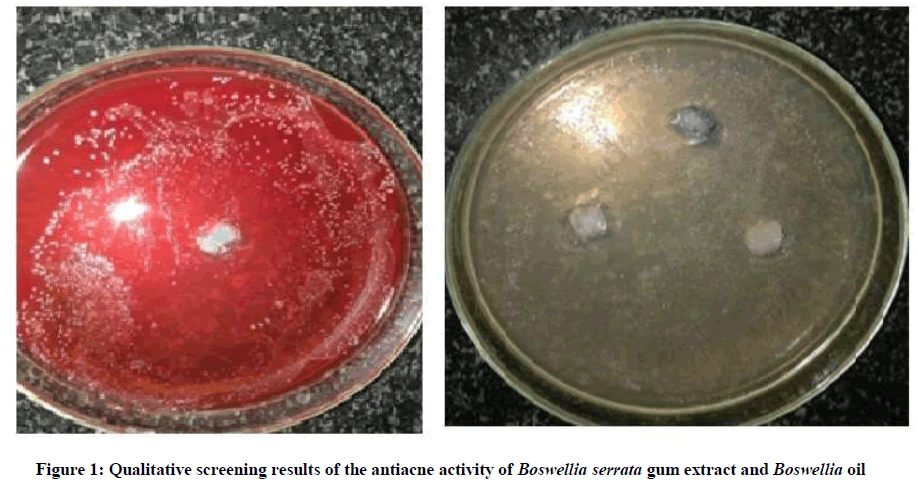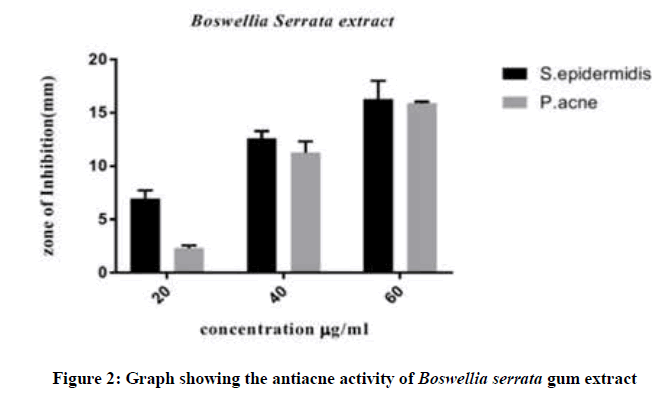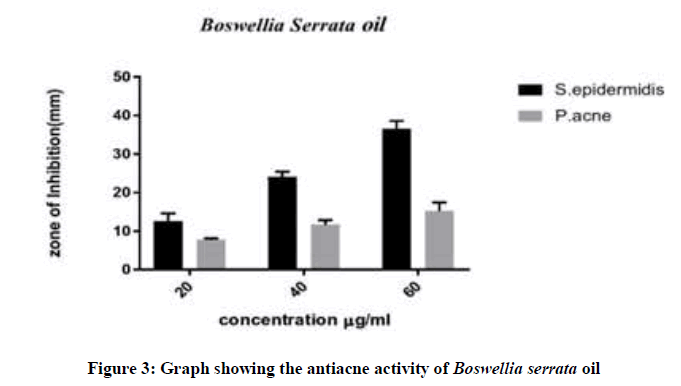Research Article - Der Pharma Chemica ( 2018) Volume 10, Issue 1
Investigation of Anti Acne Potentiality of Boswellia serrata Roxb. Gum and Oil
Satpute KL1*, Dr. Kalyankar TM2 and Dr. Chaus WN3
1Nanded College of Pharmacy, Nanded, Maharashtra, India
2School of Pharmacy, S.R.T.M. University, Nanded, Maharashtra, India
3Dayanand College of Pharmacy Latur, Maharashtra, India
Abstract
Acne vulgaris is a common skin disorder characterized by non-inflammatory and inflammatory lesions. This study has been taken to investigate in vitro antiacne activity of ethanolic extract of Boswellia serrata gum and its oil. In this study, the selected Boswellia gum extract were evaluated against the Propionibacterium acnes, Staphylococcus epidermidis. These bacteria are the main cause for acne. Agar well diffusion method is used for antiacne study and inhibitory activity is checked against P. acne and S. epidermidis compared to the marketed tetracycline disc and DalacinTM (1% clindamycin phosphate solution) as positive control. From this study it was concluded that B. serrata oil is more effective than B. serrata gum and hence it can be used for topical therapy of acne vulgaris.
Keywords
Acne vulgaris, Boswellia serrata gum, Boswellia serrata oil, Antiacne, Propionibacterium acnes
Introduction
Acne vulgaris is a chronic skin disease of the pilosebaceous follicle characterized by non-inflammatory (Open and closed comedones) and inflammatory scratchs (Papules, pustules and nodules). Its pathogenesis is multifactorial-the interplay of bacterial, hormonal and immunological (Inflammatory) factors results in the formation of acne scratchs. Although acne is a not a life-threatening disease, but it has detrimental impact on the value of life of affected individuals. Fortunately, acne is readily responsive to the wide-range of available medications, with the goals of therapy being to clear the lesions, prevent scarring and less side effects and psychosocial sequelae [1-3].
Lot of drugs is being used for skin disease, but few have indicated drug resistance. The search for newer drug to treat acne is a global challenge for preoccupying research institutions, pharmaceutical companies and academia, since many infectious agents are becoming resistant to synthetic drugs [4]. One way to prevent antibiotic resistance of pathogenic species is by using new herbal compounds. Therefore it has necessitated renewed interest in nature as a source of effective and safer alternatives in the management of acne disorders [5]. Many commercial formulations which are effective against skin diseases are available, yet the possibility of getting treatment of skin diseases with a cost-effective drug preparation is must. Many of the allopathic drugs used are advocated to be costly, have problems of drug resistance; many are toxic at certain concentration, may be harmful to humans handling them and may contaminate the environment as well. On the other hands lie comparatively safer herbal drugs. which are these days gaining significance due to their less cost, ease of use and are considered to be free from risk of harming humans handling them as well as they hardly contaminate the environment.
Medicinal herbs as a potential source of therapeutic aids have attained a significant role in health system all over the world for both humans and animals, not only in the diseased condition but also as potential material for maintaining good health. Since time immemorial, medicinal plants, nature’s hidden and to a large extent unexplored treasure, has been used virtually in all human cultures around the world (over 75% of the population) as a source of safe and effective medicines [6].
Herbal drugs have found wide spread use in many countries not only because they are easily available and are cheaper but an important reason has been the notion that they are safer than synthetic drugs which may not always be true. According to World Health Organization (WHO) guidelines, an herbal product needs to be standardized with respect to safety before releasing it into the market [7].
Propionibacterium acne is a microorganism that stays in the oily region of the skin's pores. This bacterium can aggravate an immune response which causes red, swollen bumps to develop on the skin. The selected boswellia gum and oil extract were evaluated against the Propionibacterium acne, Staphylococcus epidermidis. These bacteria are the main cause for acne [8,9].
Boswellia serrata Roxb. It is a tree of moderate size and deciduous. It has height, 16-18 m and upto 2.4 m in girth, with a spreading flat crown. Bark is thick, greenish to ash-coloured, peeling off in thin smooth flakes.
Young shoots and leaves are green in colour, pubescent. Leaves are imparipinnate, leaflets are 8-15 in pair, lanceolate opposite, sessile, more or less deeply crenate, apex generally obtuse. Flowers are bisexual. Calyx small, 5-7 cleft, petals 5-7 in number. Stamens are 10-12, inserted at the base of the red annular fleshy disk. Ovary 2-3-celled, half immersed in the disk; 2 collateral ovules in each cell. Fruit 3-valved, the valves separating from the dissepiments which remain attached to the axis. Seeds are 3 in number, enclosed in heart-shaped stones attached to the inner angle. Cotyledons trifid, lobes laciniate and radicle superior [10,11].
According to traditional clame B. serrata is also used to treat skin disorders like pimple, scars, eczema and dermatitis etc., nowadays in youngsters acne is common occurring skin infections, throught in India. B. serrata is one of the most valued plant in Ayurveda. “Gajabhakshya”, is a Sanskrit name and salai guggle is a common Indian name for Boswellia. There are free renowned ancient texts of classical Ayurvedic Science, which has its roots in India. In Ayurveda this plant describe for the antirheumatic (antiarthritis) activity and for dermal disorder. In addition to its beneficial use for arthritis, it is also reported in traditional Ayurvedic and Unani texts as an effective remedy and used to treat the number of disorders such as diarrhoea, dysentery, ringworm, boils, fevers, skin and blood diseases, cardiovascular diseases, mouth sores, bad throat, bronchitis, asthma, cough, vaginal discharges, hair-loss, jaundice, hemorrhoids, syphilitic diseases, irregular menses and stimulation of liver. It is also used in treatment of diaphoretic, astringent, diuretic and acts both as internal and external stimulant. Modern medicine and pharmacology and clinical trial point out to its use as an antiarthritic, antiinflammatory, antihyperlipidemic, analgesic and hepatoprotective. It is found in the dry forests of Punjab, Western Himalaya, West Bengal region, and Maharashtra (konkan) regions of India [12].
Extracts of B. serrata have been clinically used for the treatment of osteoarthritis of the knee and joint function, also used for ulcerative colitis and Crohn's disease with the recent research showing the great improvement of both pain as well as function compared to a placebo. B. serrata gum as a challenging alternative to Non-steroidal Anti-inflammatory Drugs (NSAIDs), which needs further investigation in pharmacological studies and clinical trials [2,3]. Composition of B. serrata gum: The B. serrata gum contains, Monoterpenes (α-thujene); Diterpenes (Macrocyclic diterpenoids such as incensole, incensole oxide, iso-incensole oxide, A diterpene alcohol [serratol]); Triterpenes (such as α- and β-amyrins); Pentacyclic triterpenic acids (Boswellic acids); Tetracyclic triterpenic acids (Tirucall-8,24-dien-21-oic acids). Oleo gumresin contains triterpenes of oleanane, ursane and euphane series [13].
Materials and Methods
Collection and authentication
The Boswellia gum was collected from local market of Bhopal, Madhya Pradesh and authentication was done at Agarkar Research institute Pune.
Extraction
The shade dried and coarsely powdered (500 g) Boswellia gum was subjected to Soxhlet extractor, using ethanol. The extracts were then concentrated to dryness under reduced pressure and controlled temperature, respectively and then preserved in a refrigerator. Percentage yield of ethanolic gum extract was found as 4.4%.
Extraction of Boswellia oil from gum
The shade dried Boswellia gums were finely powdered and Boswellia oil was extracted by using Clevenger apparatus, through hydro distillation method with a flow rate of 4 ml/min for 4 h. Percentage yield of Boswellia gum oil was found as 2.8%.
Phytochemical screening
Phytochemical screening of B. serrata gum extract and B. serrata oil was done and results were shown in Table 1 [14].
| Tests | Boswellia serrata gum extract | Boswellia serrata oil |
|---|---|---|
| Carbohydrate | + | - |
| Proteins | + | - |
| Amino acid | + | + |
| Fat & oil | + | + |
| Steroids | + | + |
| Volatile oil | + | + |
| Alkaloids | + | + |
| Glycosides | + | - |
| Phenolic compound | + | + |
| Vitamin | + | - |
| Terpene | + | + |
| Flavonoids | + | + |
| Tannins | + | + |
Table 1: Phytochemical screening of Boswellia serrata gum extract and oil
Microorganism
Clinical isolates of Staphylococcus epidermidis (MTCC-435), Propionibacterium acnes (MTCC-1951) authentic bacterial strains were used in the studies which are procured from Institute of Microbial Technology (MTCC), SECTOR 39 A, Chandigarh.
Antiacne activity
Agar well diffusion method
B. serrata gum extract and its oil was tested against P. acnes and S. epidermidis which are the common and main acne inducing bacteria by determining minimum inhibitory concentration values by agar well diffusion method. The experimental protocol was modified Cai et al. The solution of boswellia gum extract and its oil were prepared using Dimethyl Sulfoxide (DMSO) as a solvent. P. acnes was incubated on blood agar plates under anaerobic conditions. A freshly grown culture was diluted with 15-20 ml of Mueller-Hinton agar and 5% of blood was poured on glass petri plates of same sizes and allowed to solidify. Agar surface of each plate was streaked by using sterile cotton swab with the reference bacterial strain. Agar plate was punched with a sterile cork borer of 4 mm size and 100 μl of each plant extract of various concentrations (20, 40 and 60 μg/ml) sample was poured with micropipette in each bore. The plates were allowed to stand by for 30 min. Then the plates were incubated at 37°C for 48 h under anaerobic conditions.
Similarly the S. epidermidis a freshly grown culture was diluted with 15-20 ml of Mueller-Hinton agar was poured on glass petri plates of same sizes and allowed to solidify. Agar surface of each plate was streaked by using sterile cotton swab with the reference bacterial strain. Agar plate was punched with a sterile cork borer of 4 mm size and 100 μl of each plant extract of various concentrations (20, 40 and 60 μg/ml) sample was poured with micropipette in each bore. The plates were allowed to stand by for 30 min. Then the plates were incubated at 37°C for 24 h under aerobic conditions [1,15]. The control Tetracycline disc (30 μg/ml) and DalacinTM (1% clindamycin phosphate solution) were also run simultaneously. After incubation period the zone of inhibition in mm was measured to determine the antiacne activity of plant. Qualitative screening results of the antiacne activity of B. serrata gum extract and boswellia oil was shown in Figure 1.
Result and Discussion
The purpose of this study was to explore the antiacne activity of B. serrata gum extracts and its oil. The antiacne susceptibility was measured by using agar well diffusion method. Two different strains were tested: S. epidermidis, P. acnes. These strains are chosen because of the implication in the pathology of acne that is main cause for acne. Below we have given the inhibitory pattern of the tested microorganism. Figure 1 shows the screening of antiacne activity of the tested extract and oil. The B. serrata gum extract had shown the zone of inhibition of 6.95 ± 0.778, 12.585 ± 0.686, 16.275 ± 1.732 for S. epidermidis respectively. It had shown zone of inhibition of 2.3 ± 0.283, 11.25 ± 1.061, 15.9 ± 0.141 for P. acne at a concentrations of (20, 40 and 60 μg/ml) respectively.
The Boswellia oil shows the zone of inhibition 12.5 ± 2.121, 24 ± 1.414, 36.5 ± 2.121 for S. epidermidis and zone of inhibition values of 7.75 ± 0.354, 11.65 ± 1.212, 25.15 ± 2.333 against P. acne at a concentrations of (20, 40 and 60 μg/ml) in dose dependent manner. Tetracycline disc (30 μg/ml) and DalacinTM (1% clindamycin phosphate solution) were used as positive control and the zone of inhibition shown by std. as Tetracycline 15.150 ± 1.909, DalacinTM 23.500 ± 2.121 against P. acne and 4.140 ± 1.124, 11.426 ± 1.592 against S. epidermidis. Hence the zone of inhibition shown by all the various concentrations of extract and oil was more than that of the standard which showed that these were more active against acne inducing bacteria.
The standard tetracycline disc (30 μg/ml) shows zone of inhibition 4.140 ± 1.124 whereas the B. serrata gum extract (20 μg/ml) shows 6.95 ± 0.778 and its oil (20 μg/ml) shows 12.5 ± 2.121 against S. epidermidis. Whereas, tetracycline disc (30 μg/ml) shows zone of inhibition 15.150 ± 1.909 whereas the Boswellia serrata gum extract (40 μg/ml) shows 12.585 (20, 40 and 60 μg/ml) 0.686 and its oil (40 μg/ml) shows 11.65 ± 1.212, against P. acne. DMSO had shown no activity against both the acne inducing bacteria.
In this study, we evaluated the antiacne activity of ethanolic extract of B. serrata gum and its oil which proves its traditional clame as antiacne agent (Tables 2 and 3, Figures 2 and 3). Antiacne potential of B. serrata gum and oil may be due to presence of various phytoconstituents like terpenes, phenol, favonoides; tannins etc. As Alkaloids; Flavonoid; essential oil; tannins; terpenes, phenol xanthone derivative; are a good source of antiacne agent [16].
| Concentration (μg/ml) | Zone of inhibition in mm | |
|---|---|---|
| S. epidermidis | P. acne | |
| 20 | 6.95 ± 0.778 | 2.3 ± 0.283 |
| 40 | 12.585 ± 0.686 | 11.25 ± 1.061 |
| 60 | 16.275 ± 1.732 | 15.9 ± 0.141 |
Table 2: Boswellia serrata gum extract: Antiacne activity
| Concentration (μg/ml) | Zone of inhibition in mm | |
|---|---|---|
| S. epidermidis | P. acne | |
| 20 | 12.5 ± 2.121 | 7.75 ± 0.354 |
| 40 | 24 ± 1.414 | 11.65 ± 1.212 |
| 60 | 36.5 ± 2.121 | 25.15 ± 2.333 |
Table 3: Boswellia serrata oil: Antiacne activity
Conclusion
In this present investigation, we have studied the antiacne activity of B. serrata gum extract as well as Boswellia serrata oil by using agar well diffusion method against P. acne and S. epidermidis. The greater activity shown by B. serrata gum extract and B. serrata oil as compared to standard tetracycline disc and dalacinTM (1% clindamycin phosphate solution) as positive control. But the antiacne activity shown by oil is comparatively more effective than B. serrata gum extract. Hence from this study the Boswellia oil was found to much more activity not only as compared to B. serrata gum extract but also as compared to standard. Thus boswellia oil was found to have good potency against acne inducing bacteria, so it can be used to develop antiacne formulation and can be tested on preclinical and clinical study.
References
- N. Hamid, B. Mahmoud, S. Najmeh, M.N. Atefeh, S.A. Shirin, R.K. Mahmoud, Jundishapur J. Microbiol., 2015, 8(11), e25580.
- "USDA GRIN Taxonomy", 2014, 15.
- M.Z. Siddhiqui, J. Pharm. Sci., 2011, 73(3), 255-261.
- P.S. Latha, K. Kannabiran, African J. Biotechnol., 2006, 5, 2402-2404.
- K.F. Chah, C.A. Eze, C.E. Emuelosi, C.O. Esimone, J. Ethnopharmacol., 2006, 104, 164-167.
- D. Sandya, A. Akbar, G. Mahesh, G. Bhaskar, M. Yogesh, Der Pharmacia., 2010, 2(1), 285-290.
- M. Arnabaditya, D. Chandan, D. Sujit, C.S. Durga, Int. J. Compre. Pharm., 2010.
- R. Chanda, T. Poornima, S. Vikas, Int. J. Res. Pharm. Biosci., 2013, 3(1), 1-16.
- The Wealth of India, Raw Materials: Council of Scientific and Industrial Research, Vol. 1, Anon (CSIR), New Delhi, 1948.
- The Ayurvedic Pharmacopoeia of India Part-I: Government of India Ministry of Health and Family Welfare Department of Ayush, 2008, 168-169.
- Indian Medicinal Plants, Orient longman, 1996, 5, 184-187.
- European Scientific Cooperative on Phytotherapy, E/S/C/O/P Monographs: The Scientific Foundation for Herbal Medicinal Products, Second Edition, Supplement, 2009, 184.
- I. Mohammed, Z.U. Khaja, L.N. Mangamoori, Int. J. Pharm. Appl., 2011, 2(1), 89-98.
- K.R. Khandelwal, Practical Pharmacognosy Techniques and Experiments, 10th Edi., Nirali Prakashan, Pune, 2003, 149-158.
- V. Aditi, S. Pranav, Int. J. Pharm. Pharm. Sci. Res., 2012, 2(3), 61-66.
- A. Hanieh, F. Mehranz, A.K. Ali, A. Mohammad, Fitoterapia., 2012, 83, 1306-1317.






